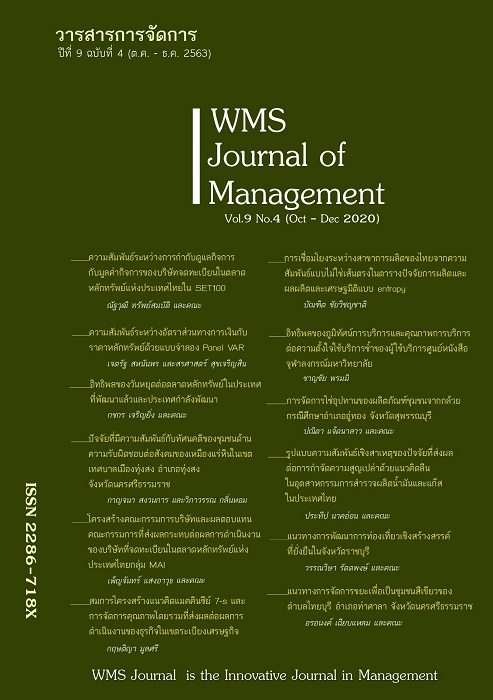Guidelines for Waste Management to Green Community of Thaiburi Sub-district, Tha Sala, Nakorn Si Thammarat Province
Main Article Content
Abstract
Waste is a problem affecting communities and the environment. The objectives of this study were to study the community waste management guidelines and waste from the developing market into a green community. It is a qualitative research. This study used the content analysis as method through in-depth interviews with a semi-structured interview. The respondents of this study were sampled by using a purposive sampling technique by being a leader in the community, namely the village headmen of 10 villages, the Thai Buri Sub-District Administrative Organization staff 4 persons, and the village scholars 2 persons. The results of the study showed that most of the waste in the Thai Buri sub-district was grass scraps, branches, food waste, general waste, and recycled waste. The community manages its household waste through incineration and takes it to the empty area. Including the local government department, there is a lack of budget, tools, and equipment for waste management. Therefore, to manage waste to be a green community, there should be guidelines for waste management, divided into 3 levels: the first is upstream level, it is the waste source. There should be community awareness of the separation to reduce the amount of waste. The second is midstream level, it should have the correct collection and delivery of waste and the last one is downstream level, the waste disposal or utilization methods should be correct. Including the market where the community is developing should be managed in the form of a green market. Focus on the conservation of natural resources and the environment and reusable packaging. The process of managing the waste requires the community government agencies and related departments are involved in the management in every part.
Article Details
References
Bordikan, S. (2018). A Study on the Guideline for Management of Garbage in Nareng Sub - District Municipality, Noppitam District,
Nakhon Si Thammarat Province. (Master degree’s Thesis, MahachulalongkornRajavidyalaya University, Thailand).
Chulajat, R. (2018). Guidelines for Waste Segregation Management and Awareness Building among City Residents. Retrieved from http://www.dsdw2016.dsdw.go.th
/doc_pr/ndc_2560-2561/PDF.
Kaewma, J. (2017). Consumer Values and Product Categories that Influence the Decision to Buy Products Using the Concept of Environmental Product Design. (Master degree’s Thesis, Bangkok University, Thailand).
Kaewsuksai, P. (2006). The study for the approach of Solid Waste Management at Srinakharinwirot University, Onkarak
Campus. (Master degree’s Thesis, Srinakharinwirot University, Thailand).
Kamnoettho̜ng, S. (2016). lǣng kamnœ̄t khaya. [Source of waste]. Retrieved from https://ewt.prd.go.th/ ewt/region4/ewt_news.php?nid=78057&filen ame=index&nid=78057&filename=index.
Act Public Health, (1992). Act Public Health B.E.2535. Retrieved from http://web. krisdika.go.th/data/law/law2/%a136/%a136- 20-9999-update.pdf
Nuanma, K., Ritthiro̜t , T. & Sakunchai, S. (2016). Development of the solid waste management system of Non Kom Sub- district Municipality, Phu Pha Man district, Khon Kaen Province. Research and Development Journal, Loei Rajabhat University, 11(38), 77-85.
Office of Natural Resources and Environ mental Policy and Planning (2019). parimān khaya mūnfō̜i chumchon. [The amount of solid waste of the community].
Retrieved from http://www.onep. go.th/env_data/2019/
Otthon, P. & hanphachoen, R. (2012). On Site Solid Waste Management Guidelines for Udonthani Urban Area. Built Environment Inquiry, 11(1), 96- 113.
Pollution Control Department, (2009). rāingān sathānakān monlaphit pī sō̜ngphanhārō̜ihāsipʻet. [Waste Situation Report]. Retrieved from http://www.pcd.go.th/
Siriarphanont, S. (2018). The Recyclable Waste Management: International Experiences and Applications for Thailand. The national Defence College of Thailand Journal, 60(1), 103-114.
Sutthiphapa, N., & Phianchana, A. (2020). Guideline for Waste Management to Participation People at Municipal Trakanphutphon, Trakanphutphon District,
Ubonratchathani Province. Research and Development Journal, Loei Rajabhat University, 15(53), 62-73.
Wipapornpong, L. (2012). Health Impact from Solid Waste in Palandonkaew Village,Tungsatok Subdistrict, Sanpatong District, Chiang Mai Province. (Master degree’s Thesis, Chiang Mai University, Thailand).
Yenpiam, K., Raksuwan, A. & Kanjanawong, D. (2020). Guidelines for the Efficiency Development of Waste Disposal Management of Hua Hin Municipality. Suan Dusit Graduate School Academic Journal. 16(1), 19-33.


